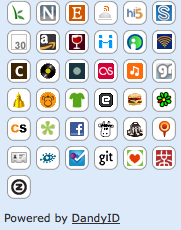If you're reading this post it's probably because you're a pretty heavy internet user and you've realised that you've got a few social networking profiles up your sleeve. You might be starting to realise that having a nice-looking profile page which points your friends to your other profiles is a good idea.
But there are so many questions to answer. Which profile page do you choose? What if you use niche social networks? Should you use more than one profile page? Should you set the profile up for professional use or for friends? Where should you direct people? All of these are important questions, and they're all best answered by looking at what's available.
Google Profiles
Google profiles are becoming increasingly popular. They're easy to set up, because Google will suggest links it already thinks are associated with you. Besides being a little creepy, this feature does help to make things quick to set up. Google profiles are also linked to Google Buzz, so make sure you check all your privacy settings there if you set this up.
Hint: For professional profiles, ensure you set up a Flickr set just for professional-friendly photos and link to that from your professional profile. Much as your kid's birthday party pictures are cute, it's probably worth keeping them separate from your business networking. If need be, read more on maintaining a professional profile.
Claim.ID
This is a great way to keep track of everything. Load in all your important profiles, blogs and other related links, then categorise and explain them for your visitors. ClaimID lets you declare whether the link points to something "About you" or "By you" amongst other things. This way, you can showcase your own websites, plus any glowing reviews you've had from other people.
It's an easy way to create an online resume of sorts. ClaimID also lets you use widgets in the sidebar, so you can link to other networks there and add a little colour.
DandyID
This service is really easy to use, because it shows you the profile URLs and lets you fill in your username, ID number or whatever. It then really quickly checks to see if that profile URL worked or if you've made a typo.
There's a lot of networks on the list, so most social networks will be found there. It falls down when it comes to niche networks though, because there's no way of adding something not on the list. There's also no way of adding multiple IDs for any network, so if you have more than one Tumblr or Twitter profile, you have to choose just one to display.
Card.ly
Cardly is fantastic for many reasons. Firstly, it allows you to choose from a good number of social networks. Secondly, it limits you to choosing just eight of them for your profile, preventing you from going overboard. Don't worry, there's another slot for a website, so you can point them somewhere else for more information. Thirdly, it has many great skins to choose from.
The overall effect of this combination is to build a stylish landing page which won't overwhelm the reader.
Retaggr
Retaggr let you plug in your networks and create a nice-looking business card widget for you. It's basically designed for you to have a virtual business card for social networks. The free version of Retaggr is limited, but not so much that a normal user will have any problems.
A person with many blogs might run out of free website slots, but that's about it. Besides which, Retaggr are offering free upgrades at the moment and they promise the paid version is pretty cheap anyway.
Gravatar
If you write or comment on wordpress.com blogs, a Gravatar account is almost essential. Gravatar's main purpose is to make life easy for you by linking a profile photo with an email address. This way, when you comment on blogs, your picture shows up automatically.
But then Gravatar went a step further and allowed you to list verified social network profiles. These are really simple to set up - all you do is click on the service and it takes you to the authentication page on that social network.
Other Possibilities
An honourable mention needs to go to Friendfeed. It's really a lifestream, rather than a profile page, but it does allow you to create a neat badge which does everything a profile page should do - it points your friends on to your other profiles.
Other social network profile pages previously covered at MakeUseOf include:
- FlavorsMe
- Zooity
- UnHub
- ProfileFly
- SocialURL
- Protopage Portfolio builder
- Gizapage
My Recommendations
Because it's so easy to set up a Google profile and a Gravatar, these would be the first I would recommend you create. I'd also suggest using different profiles for personal and professional use (with sensible email addresses linked), using your real name for the professional profile. Yes really do this - if someone Googles your real name, which profile would you prefer they find?
Card.ly or Retaggr would be my next suggestion, since they're both such simple, uncluttered landing pages. If you still have a bit of time up your sleeve, get to work on a holistic profile at DandyID or ClaimID.
With this much information on how easy it is to set up a great profile to link your social networks, you may as well get one set up right now. Which one will you set up first? Why?





